The world of flower water has long been abounding just a huge number of different annual and perennial colors, which differ in their sizes, shape of flowers and shades. That is why every gardener every year it becomes difficult to choose "your" flower, which will become a real decoration of a plot and flower garden. Alstremeria is a tropical flower, from the name of which it is clear that it is not just an ordinary flowering plant, but a very spectacular and unusual culture that has embodied the strict beauty of lily and delicate refinement of orchid.
Such a flower has long been popular in flower stores, since the elegant bud in the shape of a fragile bell immediately attracts attention. Alstremeria can be raised independently on its site, for this, it is only necessary to clearly comply with all the rules of agrotechnology of culture culture.
In this article, consider the features and description of Alstremeria, we present the main characteristics of the most popular species and varieties of this blooming plant. As well as note the important rules and nuances of landing and care for Alstremeria in the open soil.
Features and morphological description of Alstremeria
Probably, many know that one of the most ancient and powerful civilizations was the Inca civilization. They had their own beliefs, their traditions, their talismans and symbols. A special place in the system of beliefs Incov was occupied by the Alstremeria flower, which was endowed with magic properties and was considered the gift of the gods. For a long time, this flower was called exactly the "Inca flower". In addition, this decorative plant is often called the "Lily of Incas" or "Peruvian Lily", although there is nothing in common with this flower, with the exception of similar features of the inflorescences themselves.
In many literary and scientific sources, this beautiful flower is called Alstromeria, although historically, it is still very difficult to rely on the name "Alstremeria", as it was given such a definition in honor of one scientist. It is known that the Swedish Botanist and the Karl Linney classifier called Peruvian Lily Alstremeria in honor of his best student of Claus von Alstrema, who really liked such an exotic flower and he brought seeds of two color Alstremeria to his teacher. In culture, this plant is grown over 200 years.
Alstremeria is perennial rhizuy, tuber, grassy flowering plants, which relate to the genus and alstremeria family. The natural habitat of this exotic plant is the territory of all South America, in particular Peru, Chile, Brazil. In the forests and in the meadows of these hot countries, approximately 50-100 wild species of alstremeria grows, which in height reach the maximum 1 meter. Decorative garden hybrids have a more extensive classification and count approximately 150-200 varieties that can grow up to 2 meters. It is worth noting that cultural varieties are greatly popular when growing for sale, since the cut-down alstremeria flowers can stand in water up to 2 weeks.
Description of Alstremeria:
- Alstremeria or Peruvian Lily is a perennial herbaceous plant, which, contrary to established opinion, can grow perfectly in the middle lane.
- The root system of the plant is represented by a strongly branched spine-like root. Separate roots are very juicy and fleshy. Rhizome alstremeria of the urine type, in length can reach about 150 cm. The roots contain a large amount of starch.
- The ground part of the flower is formed by thin reprehensive shoots that differ in type. There are two of all two: Vegetative shoots are distinguished by large and numerous leaves collected on the top of the ushoy. Reproductive shoots, in turn, throughout the length have a small amount of small fastened leaves.
- Alstremeria can reach about 80-150 cm, but today hybrid varieties of this plant are derived, which grow up to 2 meters.
- The leaves of this decorative plant have small dimensions and are one-piece linear sheet plates that have a slightly curved shape.
- The leaves of Alstremeria have one very amazing feature, which in the scientific world is called the process of restuction. It lies in the fact that the leaves of the plant can twist around their axis 180 degrees. This indicates that the upper part of the sheet plate is lower, and the bottom looks up. This is due to the fact that the cuts of the leaves are twisted.
- The main decoration of this plant is flowers, which in their appearance resemble lily flowers and orchids combined.
- One flower consists of 6 lanceal or shovels of petals, which are located in two circles, i.e. 3 petals in one circle and 3 in another. At the same time, on one flower there are petals of different shapes. Also one of the features of the Alstremeri flower is the fact that the petals of each circle differ also in color. The diameter of one flower can be approximately 5 cm and their form in the scientific world is called Zigomorph.
- Most often, petals are covered with points or strokes, which at the base become thinner and long.
- Shades of flowers of this exotic plant are very diverse: pink, yellow, lilac, orange, red, white, cream and others.
- On one plant can bloom from 10 to 20-30 flowers.
- Alstremeria flowers have no smell.
- Blossom falls on spring or summer, although under favorable conditions these plants can start blossoming re-at the end of summer or at the beginning of autumn.
- Pollinate bright colors of various insects, and in the conditions of the South American Hummingbird countries.
- After complete flow of inflorescences on the plant, the fruit is formed in the form of a small box, in which small spherical seeds ripen.
- Alstremeria seeds can spread independently, since after ripening the box bursts and they are spread by the wind.
- If we grow alstremeria in the middle lane, then in the winter time this fragile plant can freeze, so it is recommended to plant young seedlings in the pots and endure them on the street, and in the winter to keep at room temperature. Also, as an option, you can grow it in the greenhouse and in the greenhouse. In the southern regions of Alstremeria wonderful. However, today the breeders have brought a lot of hybrid varieties of this flower, which can winter under the shelter with a small frost.
- This plant is widely used in floristry and is grown to decorate the garden plot, and is also used by designers to compile original landscape projects.
Variety of species and varieties of Alstremeria
All the genus alstremeria consists of species plants and varieties, among which hybrids are particularly popular. It is these plants that have a more unpretentious character and a bright shade of colors. Consider the most popular types and varieties of Alstremeria, which gardeners prefer to plant on their sites.
- Alstremeria Golden. It is a bright yellow flower that grows in nature on the territory of Chile, which prefers to live in swampy areas. Depending on the variety, inflorescences can be different shades from lemon yellow to orange-red. The plant can reach a height of about 150-160 cm The main feature of this kind is its relatively good frost -. Alstroemeria golden can withstand the drop in temperature to minus 12-13 degrees.
- Alstroemeria blood-flowered. It represents a rather tall plant that may reach a maximum of 1 meter. Colors differ rich red hue. One plant can, there are about 15 pieces.
- Alstroemeria Brazilian. It is a tall plant that can reach a height of about 1.5-2 meters. The natural habitat of this species is considered to be the territory of Brazil. The leaves of the plant lanceolate and the petals are painted in rich red color, sometimes there are bronze-colored petals. Alstroemeria flowers in fluffy. In one inflorescence can blossom about 30 colors.
- Alstroemeria psittacina. The natural habitat of this species of flowering plants is considered to be the territory of Argentina. A distinctive feature is a bright orange color with a green border.
- Alstroemeria nano. This plant is undersized, which maximum height may be up to about 10 cm. The natural habitat is the area of \u200b\u200bPeru. Blossoms bright golden color with black speckles.
Popular varieties of Alstroemeria:
- Grade Alstroemeria "Alicia." It is a hybrid plant variety, which has white or pink flowers. Flowering occurs from June to September.
- Grade Alstroemeria "Beauty." It represents a sufficiently high plant that may reach 150-170 cm. The ground part is formed by direct strong stems. Flowering begins in the spring and again in September. Flowers are a beautiful shade of lilac, which sometimes becomes a purplish-blue.
- Sort of "harmony". Another hybrid of the genus alstroemeria. It is a powerful tall shrub that can reach a height of 160 cm. The stems are straight and powerful. Flowering begins around April and May, and again in September and up to the frost. Shade in bronze color with small dark streaks.
- Grade Alstroemeria "Canaria". The plant in height can achieve a maximum of 150 cm. The flowering of this variety begins approximately in May-June, and repeatedly blooms in September. Petals of a canary-yellow shade with small crap.
- Alstremeria "King Cardinal". The maximum height of the plant reaches about 1.5 m. The flowering lasts from spring to the autumn itself. Flowers of this variety are very similar to orchid flowers, petals are painted in a scarlet color. It is important to take into account that when there is a shortage of sunlight, flowers may not dismiss.
- Sort "Regina". This hybrid variety is simply a great popular among gardeners. The upper part of the stem is covered with dark green lancetony leaves. Blossom starts in approximately June and lasts until September. Flowers have a funnel shape, painted in a pink shade with shallow brown speck. All colors are collected in private inflorescences consisting of 15-20 pieces.
- Alstremeria "White Wingz". It is a fairly high plant that reaches about 2 m. The leaves are large, dark green shade, perfectly shadow snow-white inflorescences. The flowering of this plant variety lasts throughout the summer with a break in a few weeks.
- Virginia Alstremeria variety. This plant has an average height, which is approximately 70 cm. Differs in large colors, whose petals have a wavy edge. Flowering plants with snow-white colors begins with June and lasts to the most frosts.
- Alstremeria "Orange Quin". Flowers up to 70 cm high. Flower petals are painted in an apricot shade with brown specks.
Detaculation of Alstremeria: the most common ways
Alstremeria is enough just to breed independently at home. The main thing is necessary to know the main methods of reproduction of this culture. For this, the seed method and reproduction of the fission of the rhizoma is perfect. With competent observance of all reproduction rules, even inexperienced gardeners will get to grow a beautiful and regular flowering plant.
Seed reproduction of Alstremeria
- This method of reproduction is most suitable for species of alstremerium, since hybrid varieties with seed breeding may lose their maternal signs. The planting material retains its germination of 3-4 years.
- Seeds of this plant can be soiled directly into the open ground or in the seedlings containers.
- Before boarding Alstremeria seeds, it is necessary to assemble or buy in a specialized garden shop. If an adult plant is growing in your site, then you need to wait for the bunch of inflorescences and the full ripening of fruits. After that, the plant needs to cover gauze and harvest the fruits, as they are very fragile and can in their hands just crumble.
- First of all, the alstremer seeds must pass the stratification process. To do this, they are placed on storing in the refrigeration chamber for about 1-2 months.
- If you live in warm areas, then you can suck seeds directly into open soil without prior stratification. Usually this period comes somewhere in late April or in early May. Seeds need to be seeded at the end of February or early March.
- In order to sow alstremeria seeds to seedlings, prepare a suitable container, the bottom of which should be equipped with drainage holes. Place first layer of clay or large river sand to prevent moisture stagnation from the roots. Next, fall asleep with a layer of fertile nutritional soil, abundantly moisturize and spread the plants seeds over it. From above, they can be sprinkled with a thin layer, not more than 1 cm, sand or peat.
- The crushing container needs to be put on a light window sill, where the regular temperature is 18 degrees, and cover with a film or glass.
- The first seedlings will appear about 3-4 weeks, after that they need regular and moderate watering, as well as feeding. The first time the seedlings are fed by a solution of a cow in proportion to 1 to 20, and the second time you can use complex mineral fertilizers.
- When the seedlings appear three real leaves, they can be divened to separate containers.
- Two weeks before landing in open ground, it is recommended to start hardening seedlings. For this, it is carried out for some time on the air.
- Seeding seedlings are needed at a time when completely passes the threat of return freezers.
The reproduction of Alstremeria by the division of rhizomes
- This method of reproduction can be used once every two years to obtain several deteen. It is ideal for breeding varietal and hybrid alstremerius.
- It is best to spend it in the spring before the start of flowering or fall after its end. However, in the conditions of the middle band, it is best to use the spring division of rhizomes.
- It is necessary to very carefully dig up an adult plant and gently shook the soil.
- Next, it is necessary to use a sterile knife or a secateur.
- Divide the root system by 2-3 parts in such a way that each has its own formed rhizome and full shoots.
- Sections of sections need to be treated with charcoal and planted in advance prepared wells. Small decenes best land in pots and fuse in room conditions or in a greenhouse.
Landing Alstremeria - Phased description
The cultivation of Alstremeria is not such a complex process, even an inexperienced gardener will cope with all the simple stages. First of all, it is necessary to conduct preparatory work, which include the acquisition of high-quality and healthy seedlings, as well as the choice of an ideal place for landing. Next, consider all the features and characteristics of preparing for landing and actually planning the seedlings into the ground.
Stage 1. Choosing and purchase of landing material Alstremeria
- First of all, each gardener should buy healthy and suitable seedlings.
- Be sure to choose to choose the variety of alstremeria. Today, most varieties are derived for a warm climate. However, domestic and world breeders in recent years have been actively developing more resistant to cold weather.
- If you live in the middle lane, choose more unpretentious varieties.
- It is best to buy the zoned varieties of Alstremeria, which were bred in your climatic belt.
- Buy seedlings or seedlings only in specialized garden centers or agrofirms that are professionally engaged in growing plants. It is here that you can acquire a guaranteed high-quality planting material and professional advice on landing and care conditions.
- Before landing, it is necessary to carefully examine the seating material. Saplings must be elastic and green, without signs of damage and disease. The soil in the container should be clean and moistened, which indicates regular care of plants.
Stage 2. Selecting a place for landing Alstremeria
- At the next stage, it is also important to choose the right place for planting this plant.
- Alstremeria prefers to grow on well-lit solar sites, but the direct sunlight is better to avoid, especially at noon. For this, the seedlings are planted near bush or other plants, which at noon will throw a shadow.
- The selected place should also be protected from strong wind and draft.
- Do not land Alstremer's seedlings in lowlands and in the heated places, because because of this, signs of disease can begin.
- This exotic flower prefers to grow on loose, fertile, nutritious soil. The soil must be a weak reaction, and it is important to pay attention to the drainage of the soil.
- Prepare the soil is best in the fall. To do this, the selected area needs to be thoroughly overpowered by a shovel and add peat and humid into the soil. The surface must be exploded and dissolved.
Stage 3. The landing process of Alstremeria
- In the open ground, Alstremeria seedlings need to land around in the middle or at the end of May, when the threat of return freezers.
- First of all, it is necessary to prepare landing wells, the size of which should be a little more root system with an earthen room. It is also important to take into account the fact that adult plants will grow and increase in diameter. Therefore, between individual seedlings, it is necessary to leave a distance of at least 50 cm.
- At the bottom of each well, it is necessary to place a drainage layer, which will prevent stagnation of moisture in the roots and protect the plant from the appearance of disease.
- Before planting, it is imperative that it is imperative to hide the seedlings to make it easier to remove them and not damage the root system.
- Gently take out young plants and put in prepared in advance landing pit. Carefully supper the soil and press with your hands.
- After planting the plant you need to pour well.
- In order for the root system does not overheat in the sun, the rolling circle is recommended to climb peat.
Alstremeria Growing Agrotechnology: Secrets and Nuances of Care
Caring for Alstremeria is not much difficult, since this plant is distinct character. The main thing is to choose the right place to fit and further pay attention to the plant.
- Watering. It is important to pay special attention to the watering of Alstremeria. This plant prefers regular and moderate watering. In ordinary summer weather, it is enough to water the plant once a week, and in the arid period, the amount of irrigation increases twice. It is always necessary to maintain the soil in a wet state. However, it is also not necessary to overflow, since the root system can start grew.
- Loosening and feeding. After each watering, it is important to neatly loosen the soil in a rigorous circle. To reduce the weeding and provide the root system with a normal temperature, it is necessary to mulch the rolling circle.
- Feeding In order for Alstremeria to please you with their decorative views and lush flowering, it is important to regularly make feeding. It is enough to add fertilizers for a season 3-4 times. The first feeding is carried out in the spring when the plant needs to be attenuating complex mineral fertilizers with nitrogen content. In the future, in the formation of buds, the plant needs phosphorus-potash fertilizers.
- Diseases and pests of Alstremeria. This plant has good resistance to various pests and diseases, so in this issue rarely delivers the hassle to gardeners. However, occasionally, with improper irrigation mode, the flower may be affected by gray rot. If you saw a fluffy gray fluff on the ground part, then it is necessary to immediately remove all the affected areas and treat the plant by fungicides. If the plant is completely struck by a gray rot, it needs to be removed. From pests Alstremeria can hit caterpillars and web ticks. Such drugs as accuters or actara will help them.
- Preparation for winter. After complete flow of inflorescences and the ripening of fruits, it is important to carefully prepare a plant for winter. To do this, shoots need to trim about 20 cm above the surface. Next, everything is covered with fallen foliage or sweetheart, after which the bush is covered with the film and the layer of humus is poured on top. This will help protect the roots from the freezing.
Alstremeria - Photo
Alstremeria is a beautiful exotic plant, which can also be raised in the middle strip. For this you only need to clearly comply with all the rules for planting and care, as well as pay attention to the plant. And as a result, Kostik Alstremeria will delight you with bright and unusual colors, which will become an excellent decoration not only the garden, but also the rooms.

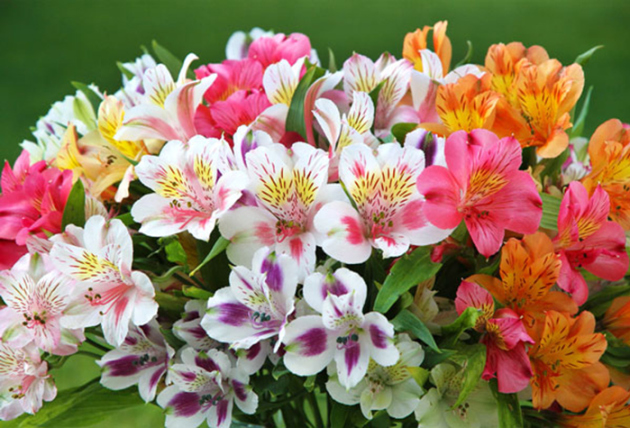
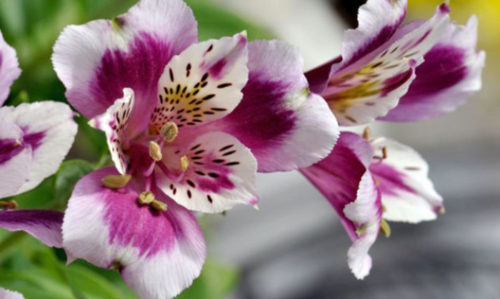
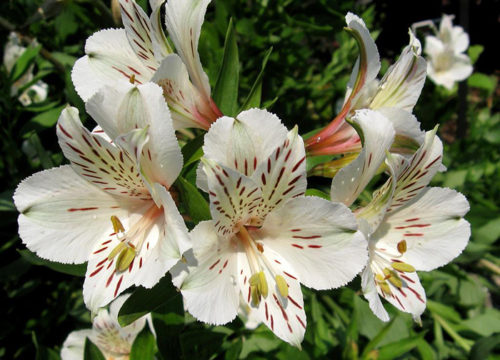
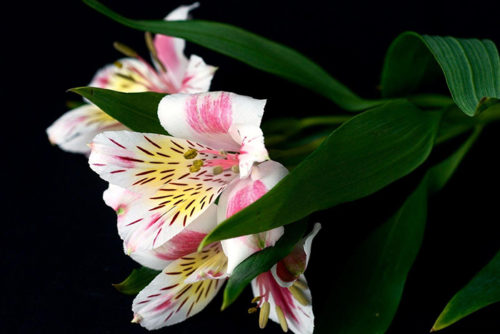
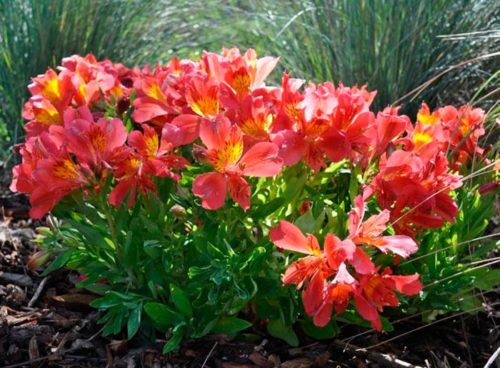
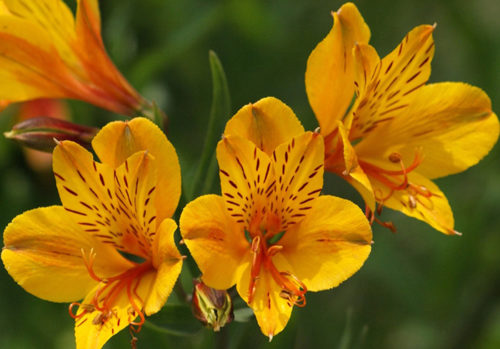
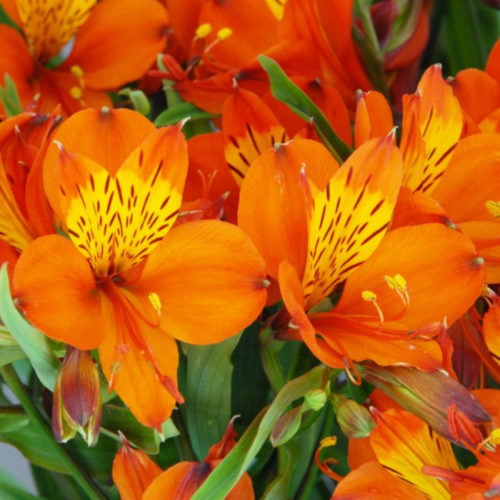


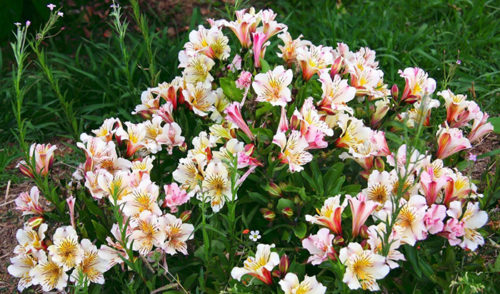

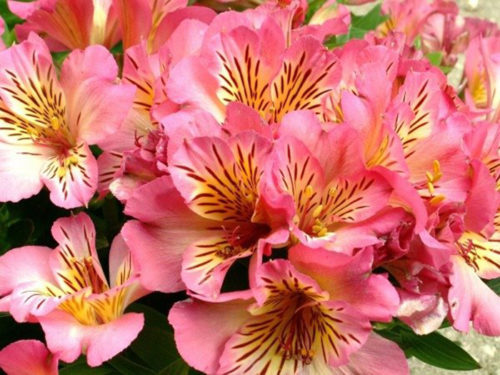
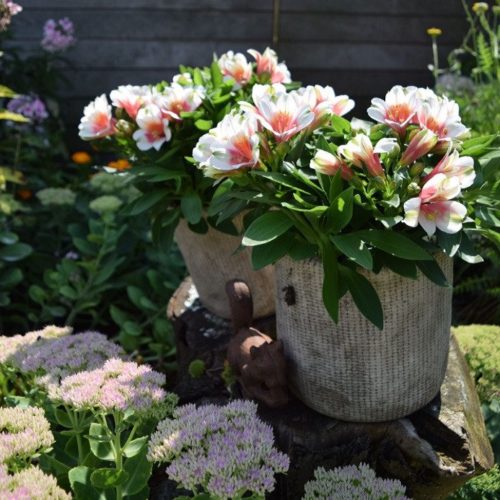
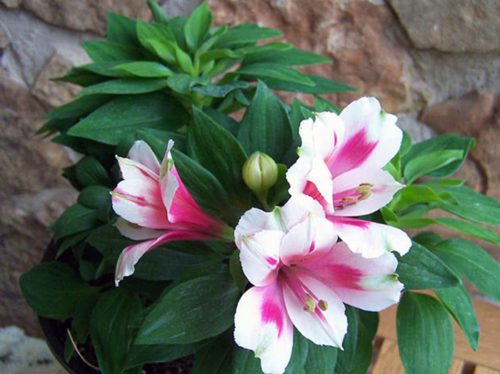
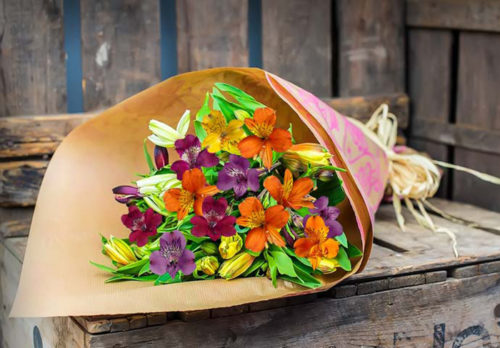
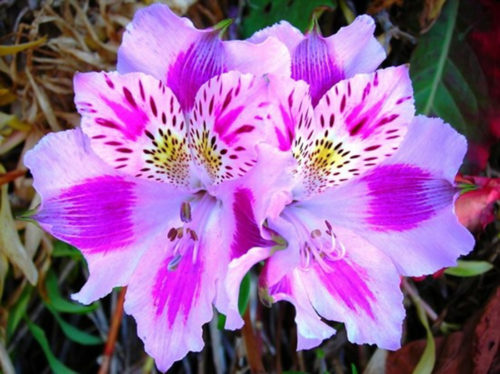













 Start a discussion ...
Start a discussion ...